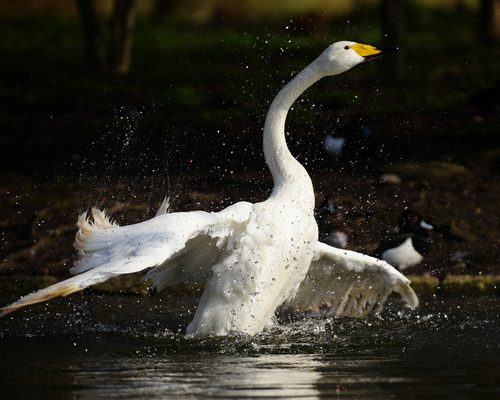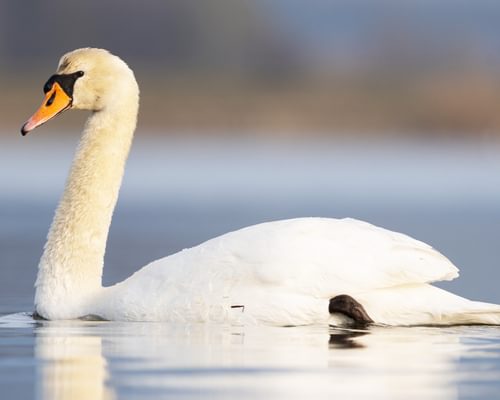Tundra Swan
Least ConcernCygnus columbianus
Visual Identification
Appearance
The Tundra Swan is a striking bird with pure white plumage, a long graceful neck, and a black bill often marked with a small yellow patch at the base. Adults typically measure 120-150 cm in length, with a wingspan of 168-211 cm.
Juveniles display grayish-brown feathers, gradually molting to white over their first year. The species shows no significant sexual dimorphism, with males and females appearing nearly identical, though males are usually slightly larger.
Size
Length
120cm to 150cm
Wingspan
168cm to 211cm
Weight
3.7kg to 9.6kg
Colours
Males and females have similar plumage
Primary Colour
White
Beak Colour
Black Yellow
Leg Colour
Black
Habitat and Distribution
Habitats
Woodland
Garden
Wetland
Coastal
Urban
Farmland
Grassland
Desert
Tundra
Rainforest
Mountain
Savanna
Distribution
Tundra Swans breed in the Arctic tundra of North America and Eurasia, favoring shallow wetlands and coastal areas. During migration and winter, they inhabit a variety of wetland habitats, including estuaries, lakes, and flooded fields.
In North America, they winter along both coasts, from Alaska to California in the west and from Maryland to North Carolina in the east.
In Europe, Bewick's Swans (the Eurasian subspecies) winter in the UK, Netherlands, and other parts of Western Europe.
Elevation Range
Sea level to 2,000 meters
Climate zones
Arctic, Temperate, Subtropical
Distribution Map
This map gives you a rough idea of where you might spot a Tundra Swan. The coloured areas show countries where these birds have been seen.
A few things to keep in mind:
- Birds might not be everywhere in the coloured areas, for example, they may be present around the coast of that country
- Where birds live can change with seasons and available food
- This map is quite simple - it doesn't show exact locations
We're working on making our maps even better! Soon, we hope to show you:
- More detailed maps for bigger countries, including state and region
- How birds move around during different seasons
Distribution by Region
Behaviour and Ecology
Bird Attributes
This feature is in beta. We'd love your feedback to improve it!
Share your thoughtsBird Attributes Explained
Our bird attributes system rates various aspects of a bird's capabilities on a scale of 0-100, based on data from field observations, scientific studies, and expert knowledge.
Attribute Categories:
- Agility: Manoeuvrability, speed, and grace in flight or movement.
- Strength: Physical power, often correlating with size and hunting abilities.
- Adaptability: Ability to thrive in various environments or changing conditions.
- Aggressiveness: Territorial behaviour and assertiveness, particularly during breeding seasons.
- Endurance: Stamina, often seen in migration patterns or foraging behaviours.
Understanding the Ratings:
- 0-20: Very Low
- 21-40: Low
- 41-60: Average
- 61-80: High
- 81-100: Very High
Remember, these attributes are relative to other bird species and don't necessarily indicate superiority.
Hover over the icon next to each attribute for more information.
Tap the icon next to each attribute for more information.
Agility
Reflects the bird's manoeuvrability, speed, and grace in flight or movement.
The Tundra Swan demonstrates considerable agility, particularly in flight and water. Their ability to run on water for takeoff and navigate long-distance migrations showcases their nimbleness. However, their large size prevents them from achieving the manoeuvrability of smaller birds.
Strength
Indicates the bird's physical power, often correlating with size and hunting abilities.
With their impressive size and ability to carry substantial body weight during long migrations, Tundra Swans exhibit significant strength. Their powerful wing beats, capable of producing audible whistling sounds, further attest to their muscular prowess.
Adaptability
Represents the bird's ability to thrive in various environments or changing conditions.
Tundra Swans show remarkable adaptability, thriving in diverse habitats from Arctic tundra to temperate wetlands and agricultural fields. Their ability to process salt water and adjust their diet from aquatic vegetation to crops demonstrates high adaptability.
Aggressiveness
Measures the bird's territorial behaviour and assertiveness, particularly during breeding seasons.
While generally not considered aggressive birds, Tundra Swans vigorously defend their breeding territories and can be protective of their young. Their large size and strong pair bonds contribute to their assertiveness when necessary, but they're not typically confrontational.
Endurance
Reflects the bird's stamina, often seen in migration patterns or foraging behaviours.
The Tundra Swan's endurance is exceptional, evidenced by their long-distance migrations spanning thousands of kilometres. Their ability to fly at speeds up to 50 miles per hour during these journeys, coupled with their longevity in the wild (over 20 years for some individuals), underscores their remarkable stamina.
Diet
Tundra Swans are primarily herbivorous, feeding on aquatic plants, grasses, and sedges.
They use their long necks to forage underwater and have adapted to grazing in agricultural fields, consuming leftover grains and crops during migration and winter.
Behaviour
Tundra Swans are highly social and often seen in large flocks during migration and winter. They exhibit strong pair bonds, engaging in synchronized swimming and vocalizing.
These birds are excellent swimmers and can run on water to gain flight, a spectacular sight during takeoffs from lakes or ponds.
Vocalisation
Tundra Swans are known for their melodious, bugling calls, often described as 'wow-wow-wow' or 'hoop-hoop'. These vocalizations play a crucial role in pair bonding and flock communication.
During flight, their wing beats produce a distinctive whistling sound, earning them the name 'Whistling Swan'.
Nesting & Breeding
Tundra Swans form monogamous pairs that often last for life. Breeding occurs during the brief Arctic summer, typically from late May to July. Pairs vigorously defend large territories in the tundra.
Nests are large mounds of vegetation built on slightly elevated ground near water. Females lay 3-5 large, creamy-white eggs, which both parents help to protect.
Incubation lasts about 32 days, with cygnets fledging after 60-75 days. The family group remains together through the first winter and migration, separating the following spring.
Lifespan
The Tundra Swan typically lives for 10 years, with a maximum recorded lifespan of 24.1 years.
Like all birds, lifespan can be affected by factors including predation, habitat quality, disease, and access to food sources.
Conservation and Status
Global Conservation Status
While currently listed as Least Concern, Tundra Swans face threats from habitat loss, particularly in their breeding grounds due to climate change.
Conservation efforts focus on protecting key wetland habitats along migration routes and wintering areas, as well as monitoring population trends.
Population Data
Global Population Estimate
317,000 - 336,000 mature individuals [3]
Global Population Trend
Trend data may be uncertain or fluctuating
Birdwatching Tips
- Look for large, white birds in wetlands and agricultural fields during migration seasons.
- Listen for their distinctive honking calls, especially in flight.
- Observe them in coastal areas and large inland water bodies during winter.
- Use a spotting scope to distinguish the yellow bill patch from a distance.
- In the UK, focus on wetlands in East Anglia and the Severn Estuary during winter.
Additional Information
Quick Facts
Other names:
Whistling Swan, Bewick's Swan
Family:
AnatidaePredators
Did You Know?
- Tundra Swans can fly at speeds up to 50 miles per hour during migration.
- They have a special gland that allows them to drink salt water, enabling survival in coastal habitats.
- Some individuals have been known to live over 20 years in the wild.
Was this bird profile helpful?
Your feedback helps us improve our content
Thanks for your feedback!
Your input helps us improve our content.
Community Experience
Community Ratings
No ratings yet - be the first to rate this bird!
Latest Community Reviews
No reviews yet
Sign in to be the first to review
Community Reviews
Create Your Free Account Welcome Back!
Join our community to rate birds and share your experiences. Creating an account is completely free and only takes a minute. Sign in to your account to rate birds and share your experiences with our community.
Your information is secure and will never be shared.
By creating an account, you agree to our Privacy Policy.
Similar Birds
References
- 2
website: BirdLife International. 2016. Cygnus columbianus. The IUCN Red List of Threatened Species 2016: e.T22679862A89644875.
View source - 3
report, 2016: Wetlands International
- 1
website, 2010: Fransson et al., EURING list of longevity records for European birds
View source

